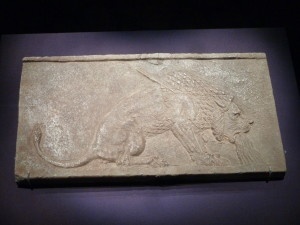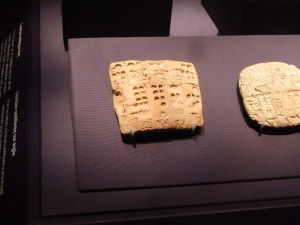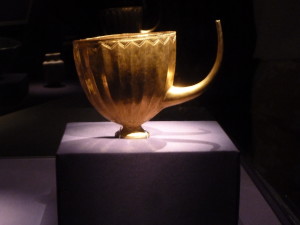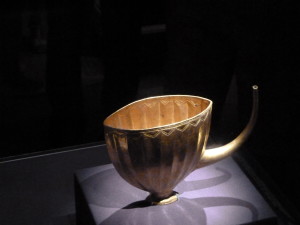A couple of weekends ago, I signed a contract to write a new book with m’colleague Alan McLeod of A Good Beer Blog. The book will be called Ontario Beer: A Heady History of Brewing from the Great Lakes to the Hudson Bay. We’re just kids in a candy store over the possibility of leafing through dusty archives and creating indexes and bibliographical footnotes. What can I say? We’re nerds.
As I was on my way to the subway, I noticed that we’re not the only ones working on beer from a historical perspective. The Royal Ontario Museum currently has a Mesopotamian exhibit that highlights some of the innovations that sprung from the fertile crescent. As an early agrarian society, Mesopotamia certainly had beer; a fact which is highlighted on the large advertisements for the exhibit encased in bus shelters around the city.
Since I was already in a vaguely historical frame of mind, I decided to get in touch with the ROM and see whether they could offer some guidance towards the exhibit. They actually provided an expert in the form of Dr. Clemens Reichel, an Associate Curator at the ROM, who took some time out of his schedule to show us around.
I say “us” because I was joined by Robin LeBlanc who writes about beer over here, and who was featured in a nice article today.
I suspect it’s fair to say that there’s not a great deal of planning that you can do for an exhibit like this if your intention is to write about it from a beer writer’s perspective. I have read beer books from the period between about 1880 and 2013 and the ancient world really only ever gets a couple of fundamentally similar paragraphs.
Sort of “development into Agrarian society… blah blah… Hymn to Ninkasi… blah blah… Does civilization exist because people wanted a drink?… and in conclusion, we owe a lot to these proto brewers whom we have included because we’re pretty sure we might have seen an article about it at some point, maybe in the Atlantic Monthly.”
The base of knowledge may well have expanded in the last 133 years or so, but since additional information would require vast amounts of research and records are typically fairly sketchy, these are the highlights that crop up. I mean, take the amount of research someone like Martyn Cornell does on a regular basis and understand how difficult it is to put together brewing history on London before tabloids. That’s nothing compared to 6500 years ago.
As a thought experiment, consider this: You want to know everything there is to know about a now closed Ontario brewery. Let’s use Conners as an example. We have the ability to track down and interview people who worked for them, which would take some research but is not impossible. We also have the ability to read contemporary articles or books about brewing in Ontario and infer from those sources about Conners as it existed. The most accurate source of information, however, is going to be financial. I can guarantee you the tax information is kicking around in a government archive somewhere.
Oddly enough, the same goes for Mesopotamia. Of course no one who made beer in Mesopotamia is still alive and they didn’t have print journalism. The financial records, though, are more or less intact.
As it turns out, the development of writing was largely due to accountancy. Part of the development of civilization has to do with accountability to each other. Without some manner of allaying mutual suspicion, we’re pretty hopeless as a species. If you were to deposit a number of bushels of grain at your local granary, you’d want there to be a record of how many bushels you had deposited. In part, Cuneiform was developed in order to do just that.
This tablet, from some period between 3300 and 3000 B.C.E., displays cuneiform symbols for various types of grain including Emmer Wheat and Barley. As you can see, there’s a heading and a column with a representative number of marks meant to represent quantity. It’s your basic inventory spreadsheet. The clay tablet technology has preserved this information. Clay had a number of comparative strengths, as Dr. Reichel pointed out. The papyrus based Great Library at Alexandria simply burnt down one day. If you expose clay to fire, it just gets harder. In some ways, clay is preferable to modern spreadsheet technology. Clay doesn’t upgrade its menu options every few years forcing you to learn how to use a styles menu or suddenly crash in the middle of an export.
This likely means that writing developed as a tool to allow us to feed ourselves. I can only imagine that in a culture where they had already developed irrigation and had likely managed to discover fermentation by dint of the fact that there was a lot of damp grain around, this means that writing probably developed in part due to beer. In a very small part. It’s practically not even worth mentioning when you consider all the other things you’d want to use grain for as well. Let’s call it about 10%.
The other illustrative artifact from the exhibit is a golden drinking cup discovered in the tomb of Puabi at the royal cemetery in Ur, dated to approximately 2500 B.C.E.
The cup presents some interesting problems. First of all, as Dr. Reichel was good enough to point out, Southern Iraq is hot. Tomorrow (July 12th) the forecast for Baghdad is 46 degrees Celsius. To convert to farenheit, that’s about 113. What kind of idiot drinks out of a golden cup when it’s 46 degrees in the shade? Think about the heat transfer. No one is actually drinking out of a cup like that. Probably you want something that is thick and made of pottery so that your beverage remains at least nominally refreshing.
The other difficulties with the cup have to do with the dimensions. First of all, it’s not really round. It is shaped a little bit like half of a pita. When you view it from the front, it’s completely normal. When you view it from a slightly elevated angle, it’s obvious that no one looking to actually drink something would have used it. There’s even a completely non-functional straw built into the side that would make it dribble on your shirt.
As a cup, it sucks. It’s a terrible cup.
As a simulacrum of a cup, it makes complete sense. It is a representational imagining of a cup. Many of the tombs in Ur had ornamental pieces like this made of gold and carnelian and lapis lazuli: Necklaces that would snap a vertebrae; earrings that would tear a lobe. The tombs were appointed with these things, as well as a number of apparently unwilling servants (as evinced by the skull trauma). You can take it with you, but eventually someone will dig it up.
These simulacra are great for pointing out how important feasting was to the culture of Sumer. To have developed to the point where you’re creating ornamental representations of tableware for an elaborate burial like that of Puabi, you can safely assume that the feasting culture was pervasive and established. It gives you a sense of what was thought of as important in terms of the details of everyday life.

I suppose if you really felt the need for an additional beer artifact, you could tell yourself that this lion is really hungover.
I should point out that these two are the main beer related artifacts in the exhibit. I can’t help but feel that the ROM overstated their case a little on the promotional posters. That said, the rest of the exhibit contains some truly amazing pieces from the British Museum. Tablet VI of the Epic of Gilgamesh, for instance. A stele with the code of Hammurabi inscribed upon it. Perhaps most impressively, a bas relief lion from the Ishtar Gate of Babylon with much of its glaze still intact. You should go and see these things. It’s good for you. And you can pop across the street to the Museum Tavern afterwards for beer if you feel your appetite hasn’t been sated.


